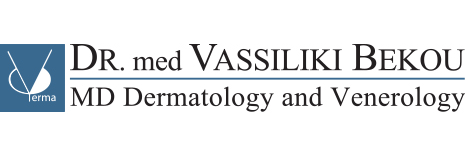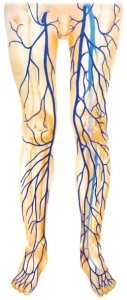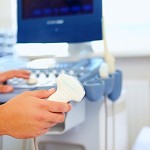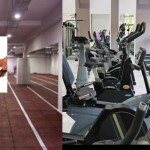Varicosis
Varicose veins: Varicosis
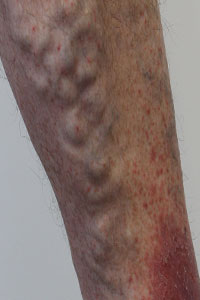 Varicose veins initially do often cause discrete heaviness of the legs. Also itching of the skin over larger varicose veins and nocturnal leg cramps may occur.
Varicose veins initially do often cause discrete heaviness of the legs. Also itching of the skin over larger varicose veins and nocturnal leg cramps may occur.
In the heat, the symptoms get worse. Women complain of different symptoms in the course of their monthly cycle.
In the advanced stage, the thickened veins are characterized in its typical wavy and branching form through the skin. Water is stored in the tissues, so oedema is provocated.
The skin may turn brown and harden. Occasionally there is a fungal infection of the skin or toenails, their relationship to the varicosity is often misunderstood.
###
Complications of varicose veins
Varicose veins are not only an aesthetic problem, but have important clinical significance. When the disease progresses, it results to problems of the drainage of the blood, resulting in increased venous pressure in the legs. Further, severe damage of the skin can take place, especially to the lower legs.
The lesion usually manifests itself initially only in discrete and non-specific symptoms, such as (one side reinforced) leg swelling, heaviness, itching or nocturnal leg cramps.
It can lead to scarring of the skin and the underlying tissue (dermato-lipo- fascio sclerosis) as well as the deposition of haemosiderin (iron containing protein), as part of a stasis (stasis dermatitis), inflammation of the superficial veins (superficial thrombosis) to an open leg (ulcer). Some serious, symptoms as a deep vein thrombosis with pulmonary embolism can also occur.
Varicosis: Varicose Veins
( For the texts and pictures books, publications, guidelines for example in awmf.org and contributions of colleagues were consulted.)
Depending on the origin of the disease the division is as follows:
Primary idiopathic varicose veins, caused by genetic susceptibility to venous wall weakness (about 95 % of cases).
Secondary varicose veins due to other diseases such as deep vein thrombosis, with formation of a bypass circuit on the superficial venous system (about 5 % of cases).
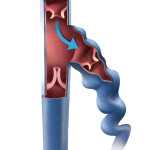
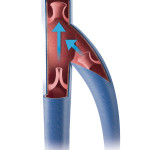 The cause of the idiopathic is a congenital vein wall or connective tissue insufficiency. The blood is transferred to the heart by the muscle pump, against the force of gravity. When the vein walls are weak, the surrounding tissue does not build up enough pressure and the movement of the legs is missing, eg through activities that require prolonged standing or sitting, so more blood remains in the legs. (image: left:regular flow, right: reflux)
The cause of the idiopathic is a congenital vein wall or connective tissue insufficiency. The blood is transferred to the heart by the muscle pump, against the force of gravity. When the vein walls are weak, the surrounding tissue does not build up enough pressure and the movement of the legs is missing, eg through activities that require prolonged standing or sitting, so more blood remains in the legs. (image: left:regular flow, right: reflux)
The veins are stretched until the venous valves no longer close them. The blood flows following the direction of the gravity and of walking, instead to the heart. The varicose veins are caused by an outflow of blood through the superficial leg veins. Consequences are edema (leg swelling), heaviness, itching or nocturnal leg cramps. Furthermore, it can lead to eczema (stasis dermatitis), inflammation of the superficial (superficial thrombosis), or deep veins (deep vein thrombosis) and up to the ulcer (gr. ἐλκος) (“open leg”). The proximal point of insufficiency (PIP), which leads to the reversal of the venous blood flow is identified by using in majority of the color-coded duplex sonography. Noninvasive color-coded duplex sonography is now the gold standard for diagnosis.
An essential therapeutic step in the treatment of varicose veins is the treatment at the PIP. If the point is proximal of the peripheral venous system, the proximal veins, including the pelvic venous system (abdomen – pelvis ) should consequently be considered as a possible source.
Surgical therapies, such as “stripping ” – the ” pull ” of varicose veins – including crossectomy are still the world’s most widely used forms of therapy. However, there are also other methods as the endovenous laser or radiofrequency therapy, and the endovenous sclerotherapy. They lead to the inner damage of the affected veins (the endothelium) thermally or chemically, so that the blood flow is prevented. Wearing compression stockings is needed after the treatment.
